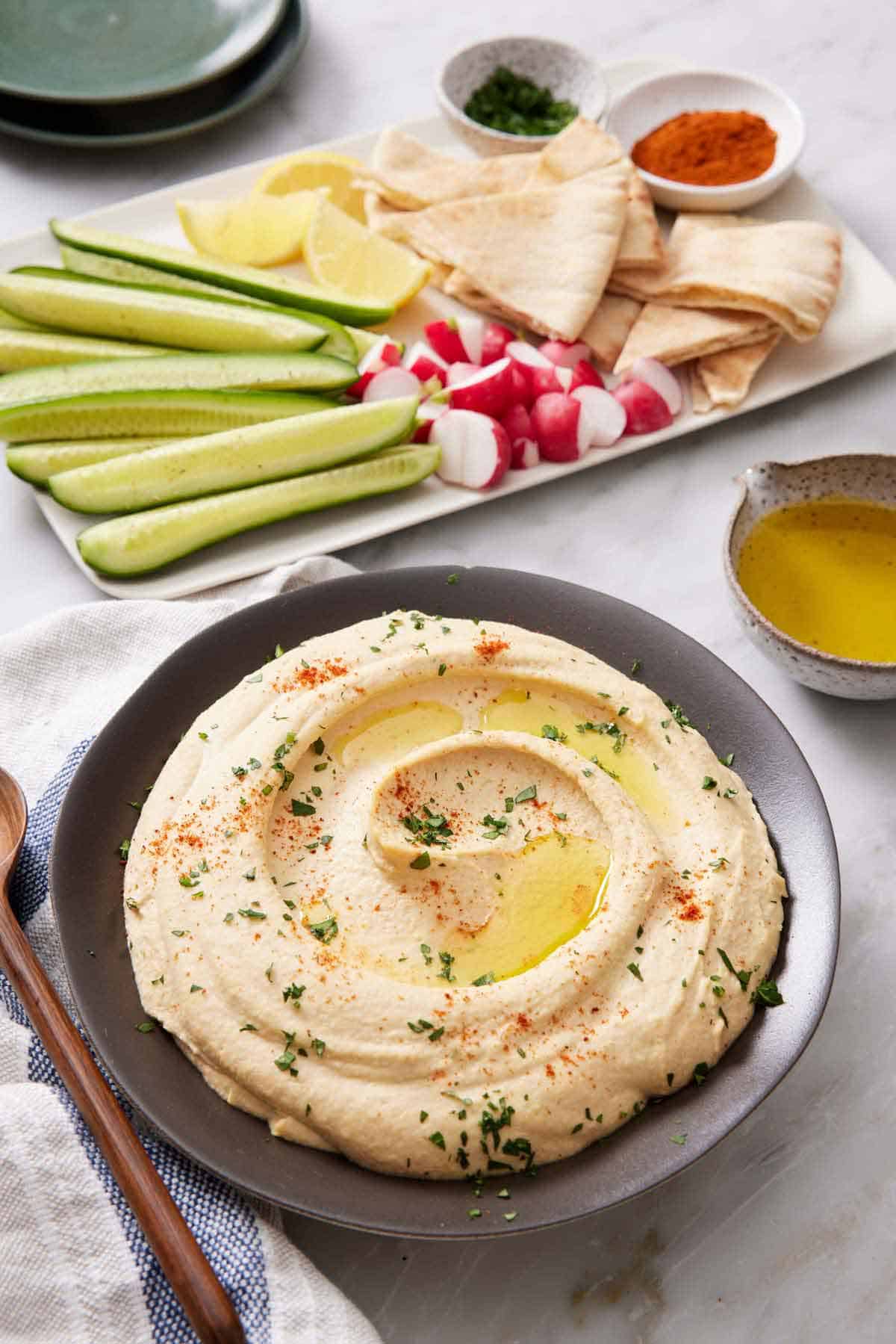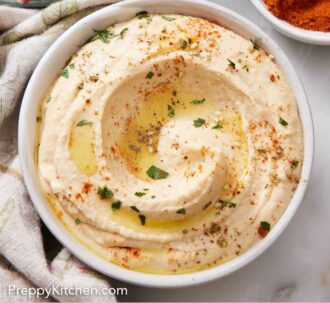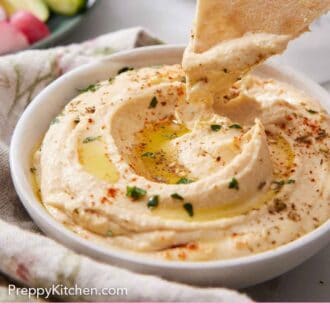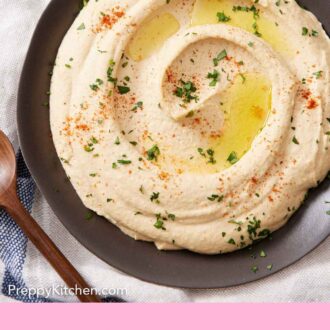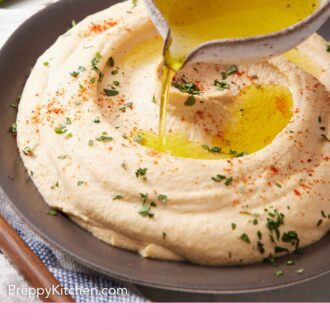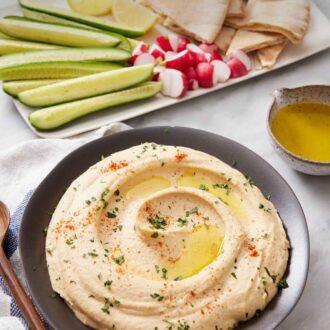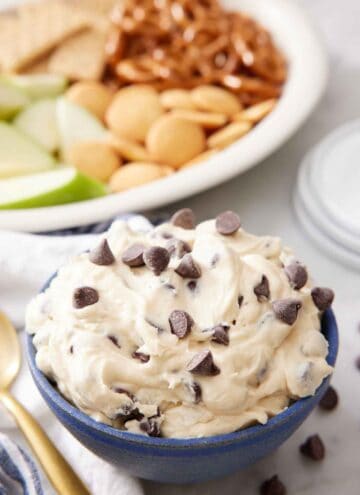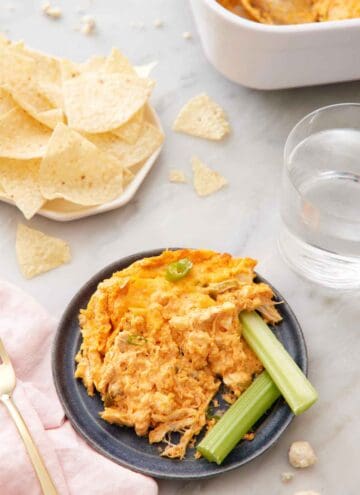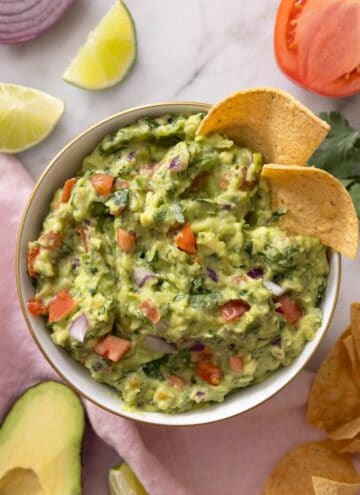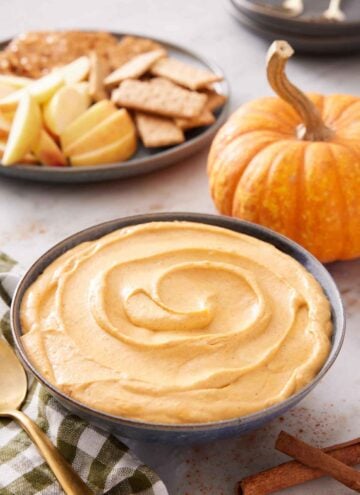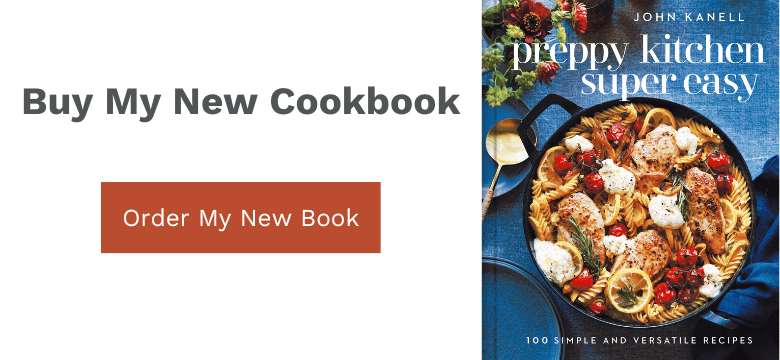Velvety, smooth hummus is the ultimate dip any time of the day. Made with simple ingredients you can find at any grocery store, this creamy hummus recipe with tahini blends with ease in a food processor. Amazing as-is seasoned with garlic and cumin, you can also garnish it with colorful or spicy toppings such as paprika, red peppers, or fresh herbs!
Serve hummus with warm pita bread and sliced vegetables as a light meal or snack, or add it to a charcuterie board with an assortment of meats, cheese, veggies, and your favorite crackers. you’ll love adding it to sandwiches or salads, too. The flavors of this recipe are superior to store-bought dips, and it’s so easy to make at home, that you’ll never want to buy it again! For more dip recipes, try my spinach artichoke dip, beer cheese dip, or pimento cheese.
What You Need to Make This Recipe
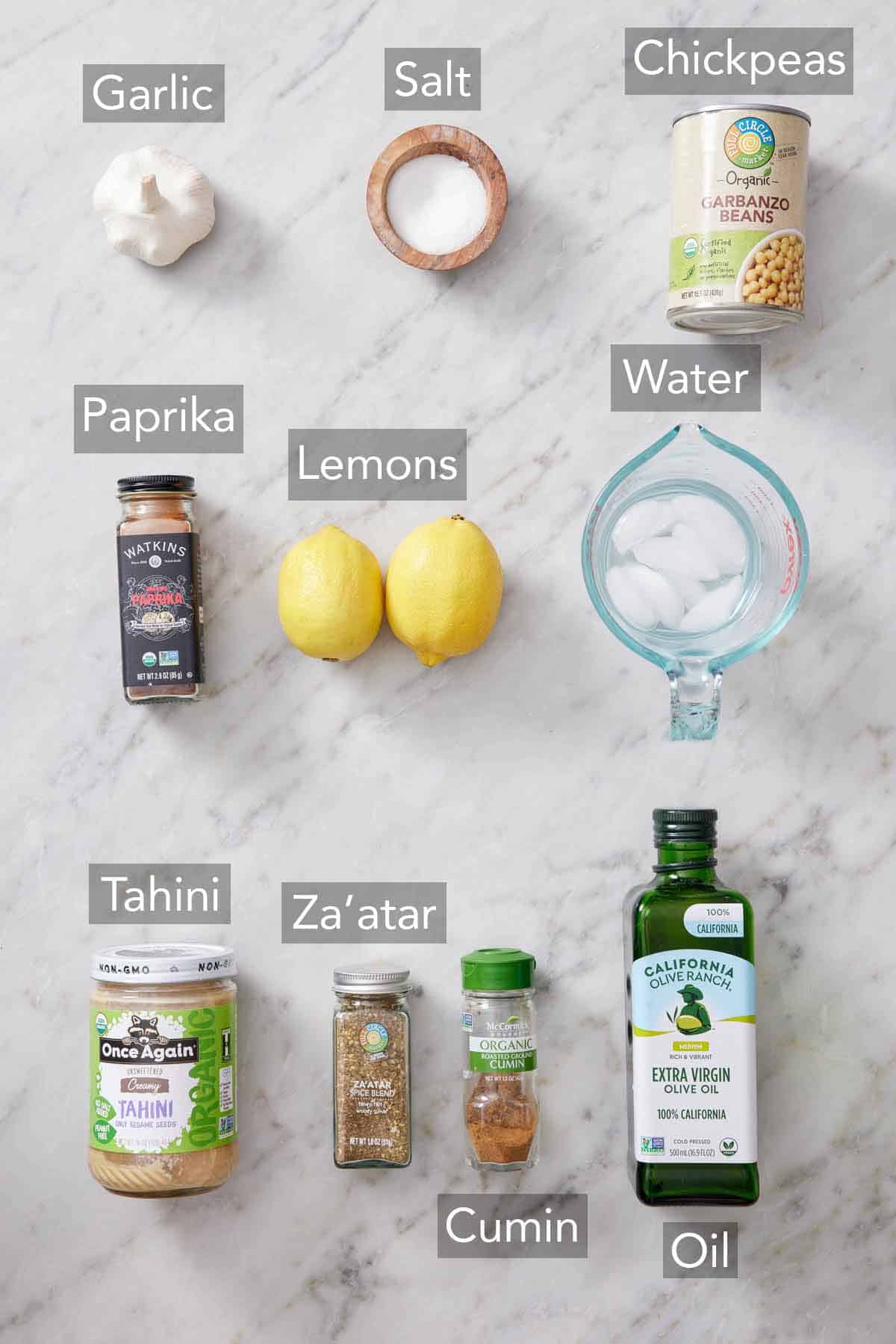
Canned chickpeas – also known as garbanzo beans, chickpeas are the traditional beans used for hummus and blend into a creamy texture. Rinse and drain the can of chickpeas before adding them to the food processor or substitute 1½ cups of home cooked chickpeas for one can.
Tahini – made from sesame seeds, tahini has a slightly nutty and earthy flavor. Smooth tahini, typically made from hulled seeds, works best for this creamy dip. Tahini often separates, so stir the sesame paste and oil together until it reaches a creamy and consistent texture before measuring it.
Lemon juice – you’ll need 3-4 tablespoons or the amount of juice from about 2 lemons. Freshly squeezed juice will have a superior flavor compared to store-bought bottled variety.
Spices – I like to use fresh garlic, ground cumin, and salt for this recipe because they add the best flavor but also create a somewhat neutral foundation for toppings and dippers. Freshly grind your own cumin seeds for an even bolder flavor.
Ice water – cold water helps the beans to blend smoothly and adds the needed liquid for smooth hummus. Add a few ice cubes to a dish or small cup along with the water to make it extra chilly.
Garnish – there are many options for garnishing this homemade hummus recipe. Try using good-quality olive oil, paprika, sumac, or za’atar, a Mediterranean spice blend.
How to Make Hummus
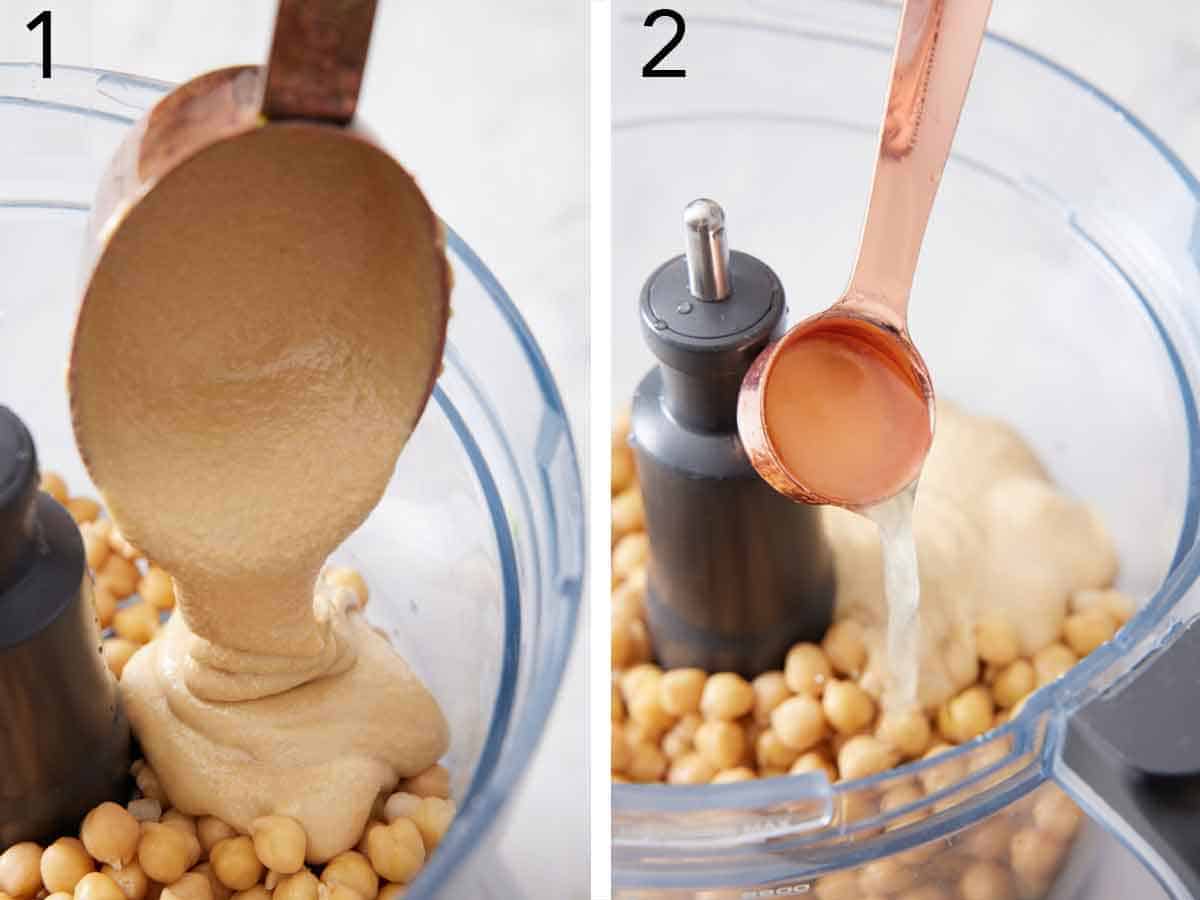
1. Add the chickpeas and tahini to the bowl of a food processor.
2. Add 3 tablespoons of fresh lemon juice and the garlic clove.
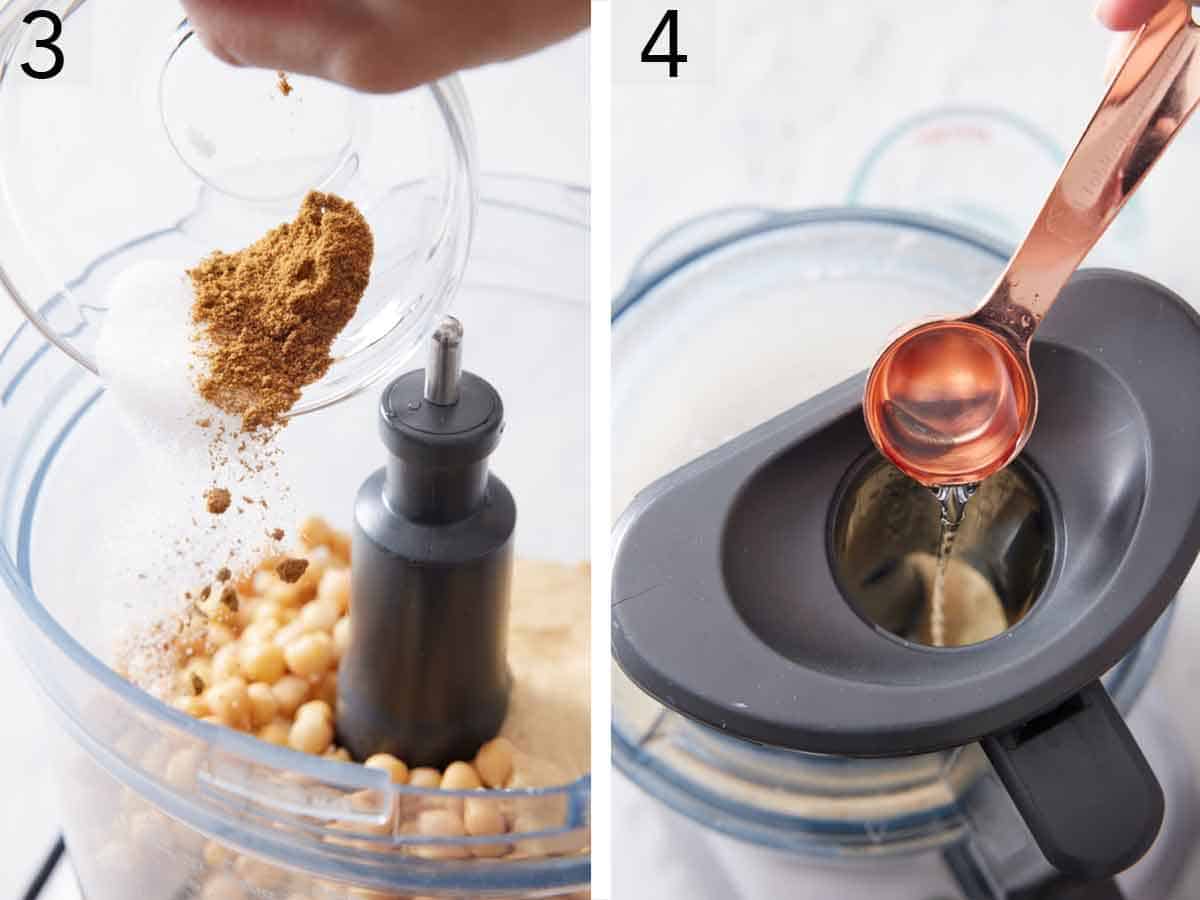
3. Sprinkle in the cumin and salt. Puree the ingredients until smooth. Scrape down the sides of the bowl if you see large pieces of chickpea.
4. With the food processor running, slowly pour in 2 tablespoons of ice water. Continue blending for about 5 minutes, or until the mixture is very smooth. It should feel warm, as well. Stop the food processor and scrape down the bowl as needed.
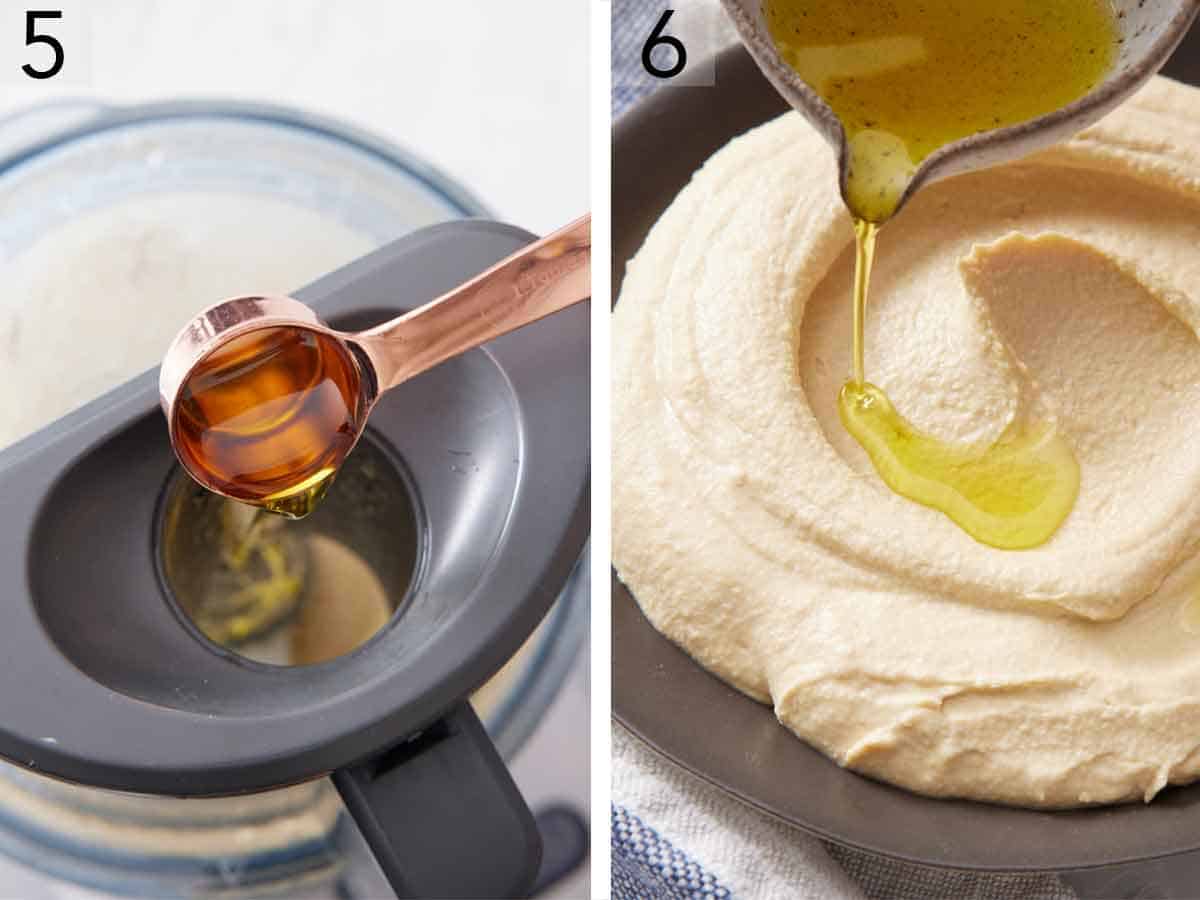
5. With the food processor running, slowly pour in the olive oil and process until combined. Taste and adjust the flavor to your preference by adding more lemon juice, salt, or cumin. For a thinner consistency, blend in additional ice water.
6. Transfer to a bowl and use the back of a spoon to create a swirl pattern on the top. Drizzle with olive oil and sprinkle with seasoning or herbs, if desired.
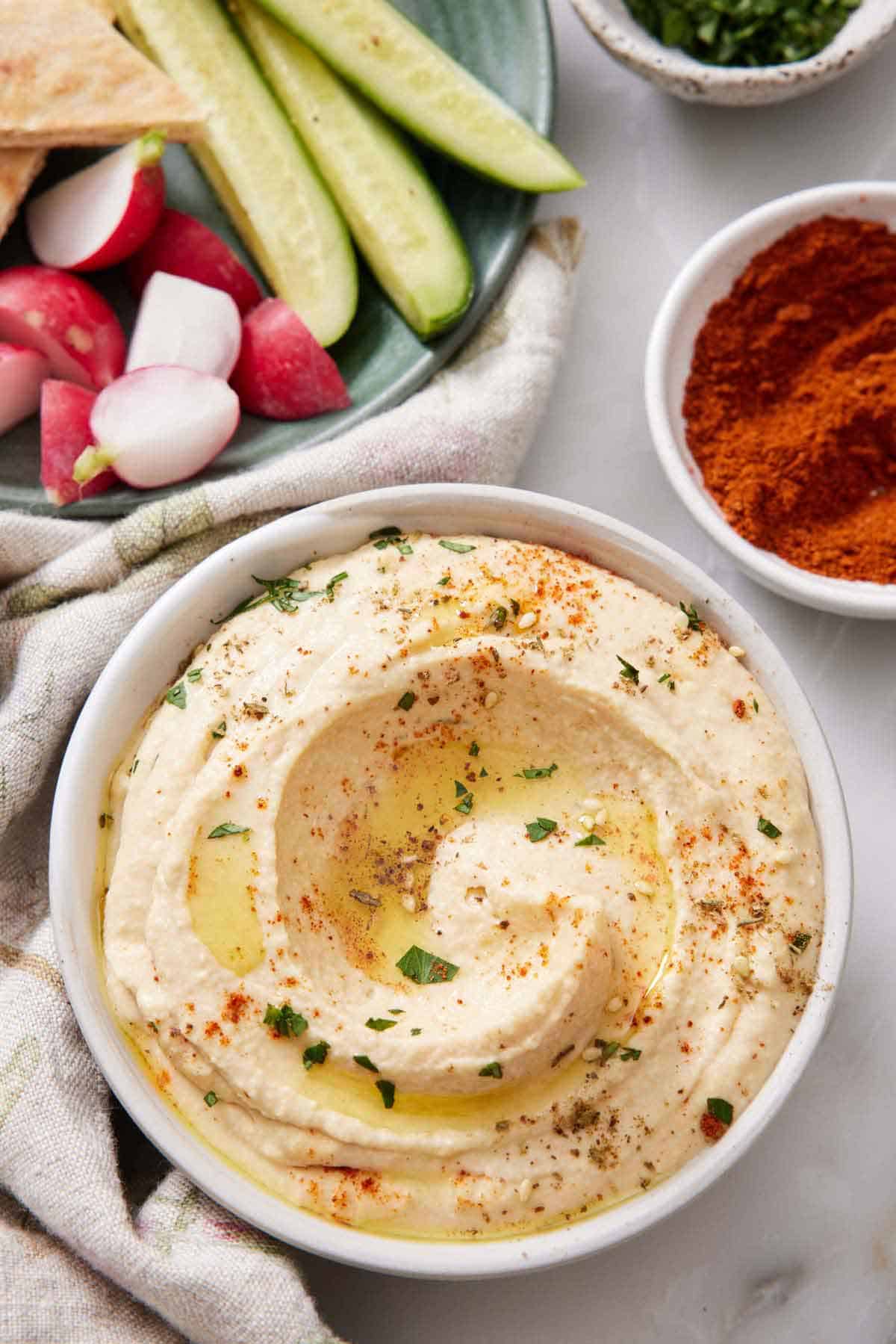
Pro Tips For Making This Recipe
- Give some ingredients a head start on blending. Instead of combining all the ingredients at once, it is important to start by blending the chickpeas with the tahini, lemon juice, and spices. This gives them a head start and helps the thick tahini disperse.
- Stir the tahini well before measuring. Make sure your tahini is stirred together very well before measuring it. The oil and paste can separate during storage, and if you get too much oil or not enough in your measuring scoop, it will affect the consistency of the finished hummus.
- Blend until very smooth and warm. A good indication that you’ve blended the ingredients long enough is if it is slightly warm to the touch. The food processor generates heat as it runs, some of which is transferred to the bowl and hummus over time. 5 minutes might sound like a long time, but hummus often needs even more time if the chickpeas are on the firmer side to start. Just keep processing until it’s super smooth and looks almost fluffy.
- Add additional water for a thinner dip or dressing. After blending completely, sample the hummus to see if you like the consistency. The best way to thin it is by adding additional liquid, so I recommend blending in 1 additional teaspoon of ice water at a time until it reaches your ideal thinness.
- Make this recipe ahead of time. The flavors of this dip are even better after sitting for a few hours in the fridge because time allows the flavors of the blended ingredients to meld.
- Extra creamy variation. In a small saucepan, combine the drained chickpeas, ½ teaspoon of baking soda, and enough water to cover the chickpeas by about 2 inches. Simmer for 10-20 minutes, or until the skins start floating in the water and the chickpeas are very soft and easily break apart. Drain and rinse with cold water. If desired, you can peel the chickpeas, and discard the firmer skin.
- Flavored hummus: Flavor this classic recipe with various ingredients like fresh herbs (dill, cilantro, basil), roasted red peppers, roasted garlic, sundried tomatoes, and olives. Add a handful of your flavoring ingredients to the food processor at the start of blending to ensure the ingredients are well-pureed.
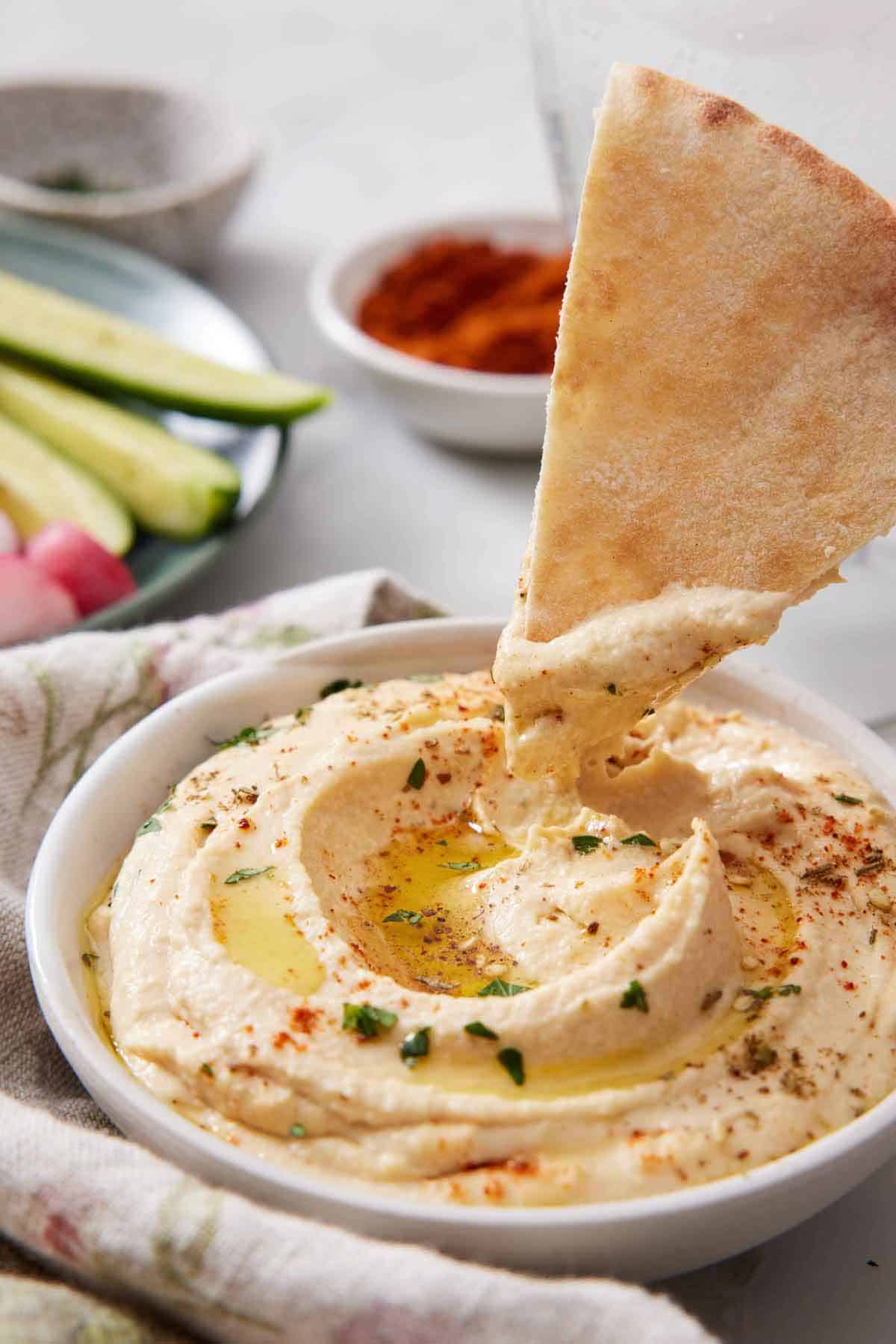
Frequently Asked Questions
Leftovers will keep in an airtight container in the refrigerator for up to a week. The flavors of the dip are even better after a few hours in the fridge, so this is a great recipe to make ahead. For easy dipping and spreading, serve at room temperature. Always discard any hummus that has developed a fuzzy spot or mold on top.
Serve with warm pita bread triangles and sliced vegetables such as radishes, carrots, or cucumber. This is a wonderful dip with crispy pretzels, toasted French bread, crackers, or pita chips. You can serve it as a spread inside wraps like chicken shawarma. You can also drizzle thinner hummus on falafel or mix in extra lemon juice and use it as a dressing on salad or veggie bowls with rice.
This is the best hummus recipe for garnishing because the garlic and cumin flavors aren’t too overpowering. Try topping this recipe with olive oil, paprika, sumac, za’atar, parsley, roasted garlic, pine nuts, sundried tomato, more cooked chickpeas, or red pepper. You can also add one or more of those ingredients into the hummus during blending. A great way to sample different flavors is to divide it into 3-4 small bowls and add different mix-ins or garnishes to each one.
Most likely, the chickpeas and other ingredients weren’t blended for long enough or the beans were hard to start. Sometimes, smaller or less powerful food processors can have a harder time pureeing firmer chickpeas. I recommend boiling them (even if using canned) in water with baking soda for the creamiest hummus.
To make this recipe with dried chickpeas, prepare the chickpeas on the stove or in a pressure cooker according to the package instructions. Add ½ teaspoon of baking soda once they are almost tender and continue cooking until they are very soft. Substitute 1½ cups drained cooked chickpeas for one can of beans.
To achieve a creamy texture, this recipe requires some high-powered mixing. If you don’t have a food processor, you can use a high-speed blender instead. Follow the same recipe steps, but add your liquid ingredients (except for the olive and water) to the blender first and add the chickpeas last. Drizzle in the ice water as directed. When you add the olive oil, only blend on low just until combined, or the oil can turn bitter.
If you’ve tried this hummus recipe, then don’t forget to rate the recipe and let me know how you got on in the comments below, I love hearing from you!
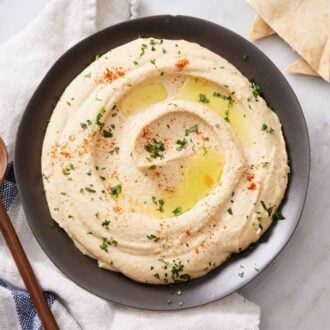
Hummus
Video
Ingredients
- 1 (15-ounce) can chickpeas rinsed and drained (or 1½ cups cooked chickpeas)
- ¼ cup smooth tahini
- 3 to 4 tablespoons fresh lemon juice (2 lemons)
- 1 garlic clove
- ½ teaspoon ground cumin
- ½ teaspoon salt
- 2 to 3 tablespoons ice water
- 1 tablespoon extra virgin olive oil
- Garnish: olive oil, paprika, sumac, or za’atar
Instructions
- In the bowl of a food processor, combine the chickpeas, tahini, 3 tablespoons of lemon juice, garlic clove, cumin, and salt. Puree until smooth.
- With the food processor running, slowly pour in 2 tablespoons of ice water. Continue processing, stopping occasionally to scrape down the bowl, until very smooth, about 5 minutes. (The hummus should be slightly warm to the touch.)
- Add the olive oil, and process until well combined. Taste the hummus and add additional lemon, salt, or cumin if desired. If the hummus is thicker than you prefer, add the additional water.
- Transfer the hummus to a serving bowl and use a spoon to make a swoopy swirl in the center. Top with olive and your seasoning of choice before serving. Hummus can be covered and refrigerated for up to 1 week, and is even better in flavor after a few hours in the fridge. Bring back to room temperature before serving.
Notes
- Give some ingredients a head start on blending. Instead of combining all the ingredients at once, it is important to start by blending the chickpeas with the tahini, lemon juice, and spices. This gives them a head start and helps the thick tahini disperse.
- Stir the tahini well before measuring. Make sure your tahini is stirred together very well before measuring it. The oil and paste can separate during storage, and if you get too much oil or not enough in your measuring scoop, it will affect the consistency of the finished hummus.
- Blend until very smooth and warm. A good indication that you’ve blended the ingredients long enough is if it is slightly warm to the touch. The food processor generates heat as it runs, some of which is transferred to the bowl and hummus over time. 5 minutes might sound like a long time, but hummus often needs even more time if the chickpeas are on the firmer side to start. Just keep processing until it’s super smooth and looks almost fluffy.
- Add additional water for a thinner dip or dressing. After blending completely, sample the hummus to see if you like the consistency. The best way to thin it is by adding additional liquid, so I recommend blending in 1 additional teaspoon of ice water at a time until it reaches your ideal thinness.
- Make this recipe ahead of time. The flavors of this dip are even better after sitting for a few hours in the fridge because time allows the flavors of the blended ingredients to meld.
- Extra creamy variation. In a small saucepan, combine the drained chickpeas, ½ teaspoon of baking soda, and enough water to cover the chickpeas by about 2 inches. Simmer for 10-20 minutes, or until the skins start floating in the water and the chickpeas are very soft and easily break apart. Drain and rinse with cold water. If desired, you can peel the chickpeas, and discard the firmer skin.
- Flavored hummus: Flavor this classic recipe with various ingredients like fresh herbs (dill, cilantro, basil), roasted red peppers, roasted garlic, sundried tomatoes, and olives. Add a handful of your flavoring ingredients to the food processor at the start of blending to ensure the ingredients are well-pureed.



